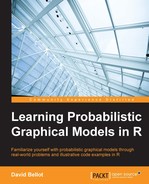In this chapter, we saw the second (and presumably most successful) approach to performing Bayesian inference, with algorithms such as rejection and importance sampling, which are based on the use of a proposal distribution simpler than the one we want to estimate.
These two algorithms are usually efficient with low-dimensional cases but suffer from long convergence problems, when they converge at all, in high dimensions.
We then introduced the most important algorithm in Bayesian inference: the MCMC method using the Metropolis-Hastings algorithm. This algorithm is extremely versatile and has a nice property: it converges toward the distribution one wants to simulate. However, it needs careful tuning in order to converge, but its convergence is guaranteed in theory.
In the next chapter, we will explore the most standard statistical model ever: linear regression. While it seems beyond the scope of this book, this model is so important that it needs to be introduced. However, we will not stop at the simple form of it but will explore its Bayesian interpretation, how it can be represented as a probabilistic graphical model, and what benefit we get from doing so.
